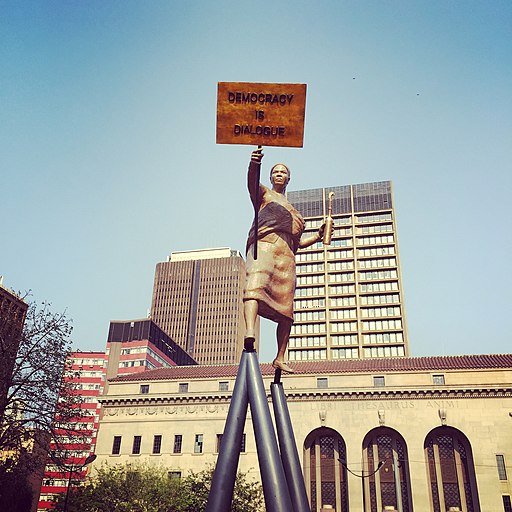South African artist and sculptor Lawrence Lemaoana has a piece called “Democracy is Dialogue” standing in front of old Johannesburg City Hall. The statue is of “a woman protester with a baby strapped to her back. She has a protest placard in one hand and a candle in the other to light her way.” Lemaoana has been a fierce post-apartheid social voice and was a critic of president Jacob Zuma. President Zuma would often publicly raise his fist, a sign of victory, but for Zuma, a call to silence criticism.
Public communication is not always communication geared toward dialogue. Donald Trump rose to the presidency through, among other things, his aggressive use of Twitter to draw attention to himself and to criticize others. Twitter’s simplicity and tendency to vitriol set the tone for Trump’s messaging. The communication wasn’t multi-directional; it wasn’t a tool of dialogue. Nevertheless, “In a 3–0 decision, the U.S. Court of Appeals for the Second Circuit held that President Trump’s practice of blocking critics from his Twitter account violates the First Amendment.” What Trump thought was a bullhorn at least required him to allow others to scream back at him. Still though, not a dialogue.
But the Second Circuit Court’s rationale for the decision draws from a more civic-minded philosophical well: because Trump’s Twitter account was a government account—official seal, held up as such, “with interactive features accessible to the public”—the First Amendment was relevant and in need of protection. After all, as the court points out, “not every social media account operated by a public official is a government account,” so if Trump had wanted to rant without response, he could have done so on an account not specifically identified as governmental. He even arguably could have done so on his reelection campaign accounts. “The court found that President Trump, therefore, ‘is not entitled to censor selected users because they express views with which he disagrees.'”
The underlying philosophical principle is just as important as the legal distinction. That underlying principle is that public, government-mediated communication with public officials is dialogical. Dialogical means having the “character of dialogue,” a discussion between two or more individuals.
That’s a profound distinction, even if it comes off as functional and factor-based in the court’s analysis. Democracy is a process, but it’s also an approach. For proponents of more participatory democracy, that approach is, among other things, dialogical—based on ongoing conversations between officials and their constituents.
But even though a court can rule that people have a right to tweet back to a public official, that doesn’t mean doing so constitutes meaningful public or constituent dialogue. Even if there are dialogic elements to social media, its underlying structures and its practices in a mass marketing context may undermine whatever dialogical function it has. Samantha McDonald, who studies how technology mediates communication between citizens and policymakers, writes at her blog: “major social media players like Facebook and Twitter were never designed to be spaces for quality policymaker engagement. Just ask Congressman Rick Crawford, who replaced Facebook with his new texting application. Or Representative Alexandria Ocasio-Cortez, who points out that these platforms are huge public health risk. In addition, why is Congress communicating to constituents through platforms that sell citizen’s data?”
It’s important to remember that not all constituent communication is about important policy dialogue (in another piece, McDonald points out that congressional staffers “report that contact can be untimely” or consist of “emotional reactions to government issues that the office cannot help”). But policy discussions with constituents are possible. Focused dialogue which is proactive and “hard-wired” into a deliberative event can result in “diverse participation,” particularly if accompanied by “balanced, factual reading material for participants; single topic focus; a neutral, third-party host; and live member participation.” Structured communication is also possible through constituent-focused CRMs—designed not for consumers, but specifically to foster official-constituent dialogues over time.

